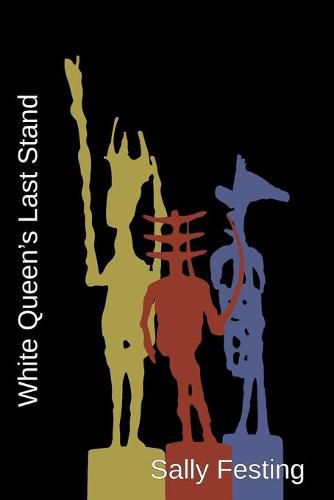Readings Newsletter
Become a Readings Member to make your shopping experience even easier.
Sign in or sign up for free!
You’re not far away from qualifying for FREE standard shipping within Australia
You’ve qualified for FREE standard shipping within Australia
The cart is loading…






This title is printed to order. This book may have been self-published. If so, we cannot guarantee the quality of the content. In the main most books will have gone through the editing process however some may not. We therefore suggest that you be aware of this before ordering this book. If in doubt check either the author or publisher’s details as we are unable to accept any returns unless they are faulty. Please contact us if you have any questions.
Sally Festing’s White Queens Last Stand is a collection with a strong ekphrastic dimension inspired by the sculptures of Germaine Richier.
French Sculptor, Germaine Richier, was the first woman to be given a solo retrospective at the Musee National d'Art Moderne (in Paris, 1956). Following her early death, she was largely forgotten in the art world. But she had a few champions. In 1955, David Sylvester asserted that ‘nobody perhaps occupies so central, so crucial a position in contemporary sculpture.’ He was right. ‘Surely one of the most original sculptors of our century’, echoed American critic and historian, Michael Gibson in 1996. ‘Form and subject matter display a no-nonsense authenticity which deserves to be prized above all else.’ Such recognition came many years before her work began to feature in academic feminist studies. She was one of the very few women artists to receive international success in the 1940s and 1950s.
I’ve been obsessed with Richier’s work for a long time, looked at it in the Tate, read about the artist, and paid my respects by visiting the landscape that was seminal to her. On Sunday, 3 March 2003, I printed ‘Stes Maries-de-la-Mer’ across the page of my holiday-diary. Wake from a siesta in the back of a Citroen parked round a stone-covered square. Hard-pollarded trees. Grubby white hotel. The rest of the page was written outside in a wobbly hand. Long grey beaches. Trees peppered with holes & striped with algae drift into weird beasts. Wedges of wood entombed in shifty, sifty sand. Great tufts of marram, flapping in the wind. Dead birds. Uprooted willows. Huge skies. Tamarisks. Perennial samphire. Sea purslane.
The unexpected part: all these plants were familiar. It was a coincidence that the landscape of Richier’s childhood had strong similarities with a spot on the North Norfolk coast that’s part of mine. I swam in her sea and felt at home. The Camargue is, of course, more ‘extreme’, and this is a word Richier used about her work. Critics used it too. Through metamorphoses, one argued, Richier appears to ask what lies at the extreme reaches of the human body.
Richier’s sculpture became a point of reference for my poetry, Because of this, some diary jottings, and comments are woven between poems as well as in the four-page Timeline.
$9.00 standard shipping within Australia
FREE standard shipping within Australia for orders over $100.00
Express & International shipping calculated at checkout
This title is printed to order. This book may have been self-published. If so, we cannot guarantee the quality of the content. In the main most books will have gone through the editing process however some may not. We therefore suggest that you be aware of this before ordering this book. If in doubt check either the author or publisher’s details as we are unable to accept any returns unless they are faulty. Please contact us if you have any questions.
Sally Festing’s White Queens Last Stand is a collection with a strong ekphrastic dimension inspired by the sculptures of Germaine Richier.
French Sculptor, Germaine Richier, was the first woman to be given a solo retrospective at the Musee National d'Art Moderne (in Paris, 1956). Following her early death, she was largely forgotten in the art world. But she had a few champions. In 1955, David Sylvester asserted that ‘nobody perhaps occupies so central, so crucial a position in contemporary sculpture.’ He was right. ‘Surely one of the most original sculptors of our century’, echoed American critic and historian, Michael Gibson in 1996. ‘Form and subject matter display a no-nonsense authenticity which deserves to be prized above all else.’ Such recognition came many years before her work began to feature in academic feminist studies. She was one of the very few women artists to receive international success in the 1940s and 1950s.
I’ve been obsessed with Richier’s work for a long time, looked at it in the Tate, read about the artist, and paid my respects by visiting the landscape that was seminal to her. On Sunday, 3 March 2003, I printed ‘Stes Maries-de-la-Mer’ across the page of my holiday-diary. Wake from a siesta in the back of a Citroen parked round a stone-covered square. Hard-pollarded trees. Grubby white hotel. The rest of the page was written outside in a wobbly hand. Long grey beaches. Trees peppered with holes & striped with algae drift into weird beasts. Wedges of wood entombed in shifty, sifty sand. Great tufts of marram, flapping in the wind. Dead birds. Uprooted willows. Huge skies. Tamarisks. Perennial samphire. Sea purslane.
The unexpected part: all these plants were familiar. It was a coincidence that the landscape of Richier’s childhood had strong similarities with a spot on the North Norfolk coast that’s part of mine. I swam in her sea and felt at home. The Camargue is, of course, more ‘extreme’, and this is a word Richier used about her work. Critics used it too. Through metamorphoses, one argued, Richier appears to ask what lies at the extreme reaches of the human body.
Richier’s sculpture became a point of reference for my poetry, Because of this, some diary jottings, and comments are woven between poems as well as in the four-page Timeline.